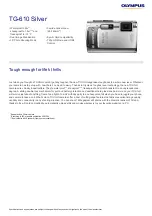
Copyright 2010 International Safety Instruments, Inc.
10
connector. Push the cable connector into the
camera connector until secure.
4.2.4 Operation
4.2.4.1 Snap the remote LCD onto the pole if
desired.
4.2.4.2 To activate the Remote LCD, simply plug
it into a camera that is already turned on or plug it
into the camera and then turn the camera on. The
remote LCD utilizes the camera battery and will
cause the battery duration time to be cut it half.
4.2.4.3 To extend or shorten the pole, simply push
and hold down the extension release button found
at the end of the first pole section and pull or push
the second pole section to desired length. Be
sure the extension release button locks in place.
4.3 ISI Dual Channel 1.2
4.3.1 The ISI Dual Channel is a 2-channel
transmitter that operates in the 2.4GHz frequency.
The transmitter is 1 watt and will diminish the battery
duration of the camera in half.
4.3.2 Attaching the transmitter
4.3.2.1 First turn the camera upside down and
take off the battery deflector by removing the 2
screws holding it in place. Place deflector in a
safe storage area. Do not discard.
4.3.2.2 Line up the transmitter screw holes with
the deflector screw holes of the camera.
4.3.2.3 Using the battery deflector screws,
securely fasten the transmitter to the camera.
4.3.2.4 Take the transmitter connector cord and
line up the red dot on the cord connector with
the flat section of the second ring of the camera
connector. Push the cord connector into the
camera connector until secure.
WARNING: Never use the camera without
either the battery deflector or the transmitter
in place. Failure to do so may cause battery
to become dislodged during use, should the
camera be dropped, hit, slammed, or banged,
thus causing the camera to stop operating.
4.3.3 Connecting Receiver to Monitor/TV
4.3.3.1 Connect the power supply to the receiver.
Use only the power supply unit supplied with the
receiver.
power video
out
4.3.3.2 The receiver is automatically “on” as soon
as you plug it in.
4.3.3.3 Connect the receiver’s Video-out to the
Video-In of your Monitor/TV.
4.3.3.4 Set your Monitor/TV to receive the signal
from the receiver. The Monitor/TV must be set to
receiver signal from the Video-In plug. Refer to
the manual supplied with your TV/Monitor.
4.3.4 Channel selection
4.3.4.1 Locate the channel toggle switch on the
bottom of the transmitter and either push forward
or backward for desired channel. The switch will
reset in the middle after selection.
4.3.4.2 Select the corresponding channel on the
receiver by use of the toggle switch.
4.3.5 Transmitting
4.3.5.1 Turn on the camera and Monitor/TV.
4.3.5.2 To select or change channels on the
transmitter, simply switch the toggle switch.
4.3.5.3 Select the corresponding channel on the
receiver by use of the toggle switch.
!





























